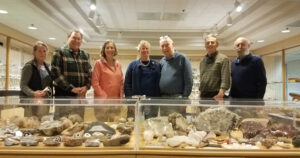This was not your typical family reunion.
In November, the descendants of Thomas A. Greene met in the Greene Geological Museum on UWM’s campus to see the incredible collection of minerals and fossils that their forefather had gathered over his lifetime. Greene was a successful Milwaukee businessman in the latter half of the 19th century. He was also a rockhound who gathered more than 75,000 fossils and mineral samples over the course of his life.
When he died, the Greene family donated his trove to Downer College, and later UW-Milwaukee.
For the first time in years, members of the family met to see their ancestor’s legacy in person – and add their own touch. University geologists are in the process of digitizing Greene’s collection by photographing every fossil and mineral and uploading them to an online archive. In a full-circle moment, Greene’s grandchildren and greatgrandchildren helped photograph some of the fossils in the collection to preserve Greene’s work and share it with the world.
“What Thomas Greene assembled here is absolutely unparalleled. This is the most impressive collection (of its type) in the world,” geologist Scott Schaefer told the Greene descendants as they gathered in the museum’s display room.
A rocky history
Thomas A. Greene was born in 1827 in Rhode Island. As a young man, he moved to Milwaukee and opened a drugstore with his partner, Henry H. Button. Their business grew and with it, Greene’s wealth.
He retired in the 1870s after the stress of his business began to take a toll on his health.
“According to family legend, he got nervous, unhappy, and depressed, and his doctor told him he should take up a hobby,” said Thomas Greene Hughes (III), the great-grandson of Thomas A. Greene.
The original Greene took that advice to heart, and then some. He had always been interested in minerals and geology, so he set about collecting specimens from around the world, and in his own backyard – if Milwaukee’s quarries counted as his backyard, that is.
“One thing I really think stands out with this collection was that Greene was interested in the best fossils, the best-preserved fossils and the best-preserved minerals,” noted Peter Sheehan, an adjunct in UWM’s Geosciences Department and an emeritus curator at the Milwaukee Public Museum. “He taught the quarry (workers) what a good specimen looked like so they would bring them to him, and he would buy them.”
“He not only knew the quarrymen; he owned the quarry,” added Thomas Hughes.
Thomas A. Greene kept his expansive collection in his home. When he ran out of room, “he cut the house in half and put in a great big exhibition hall,” Thomas Hughes recalled.
“I never heard what my grandmother’s comment was when he did that,” mused his cousin, Abigail Greene Fassnacht. Thomas A. Greene was her grandfather.
After Greene’s death, the family donated his impressive collection, along with a building to house it, to Downer College. The donation stipulated that the collection be used for public education under the direction of a geology professor. When the College merged with Lawrence College in 1964, the Greene family turned the collection over to UWM.
Education and preservation
Today, the Greene Geological Museum is housed on the first floor of Lapham Hall. It’s open to the public and often hosts field trips for area students. The bulk of the collection, though, including the thousands of fossils, are stored in the Lapham Hall basement where Schaefer and his student researchers are busy photographing each piece to build a digital archive.
After viewing the museum, Greene family members rotated in shifts to visit the small Lapham Hall stacks where drawers upon drawers of fossils line the shelves. Student workers Mikayla Walker and Nate Hodges showed Thomas Hughes how to place a fossil under a camera lens and photograph the specimen so it can be uploaded and tagged with digital imagination – when and where it was collected and the flora or fauna imprinted in it.
Schaefer was thrilled to have Greene’s family members participate in his legacy, but Thomas Hughes’ daughter, Caroline, said there’s always been a family interest in rocks and minerals.
“It is a family trait that we tend to classify and order things,” she joked, recalling family car trips where her father would point out various rock formations or quiz his kids about the angle of repose.
Caroline Hughes was largely responsible for coordinating the family trip. Her relatives traveled from Delaware, Pennsylvania, Seattle, and Chicago to see the collection. The trip was well worth it, Thomas Hughes said. “We’re very glad it’s being used,” he added.
By Sarah Vickery, College of Letters & Science
